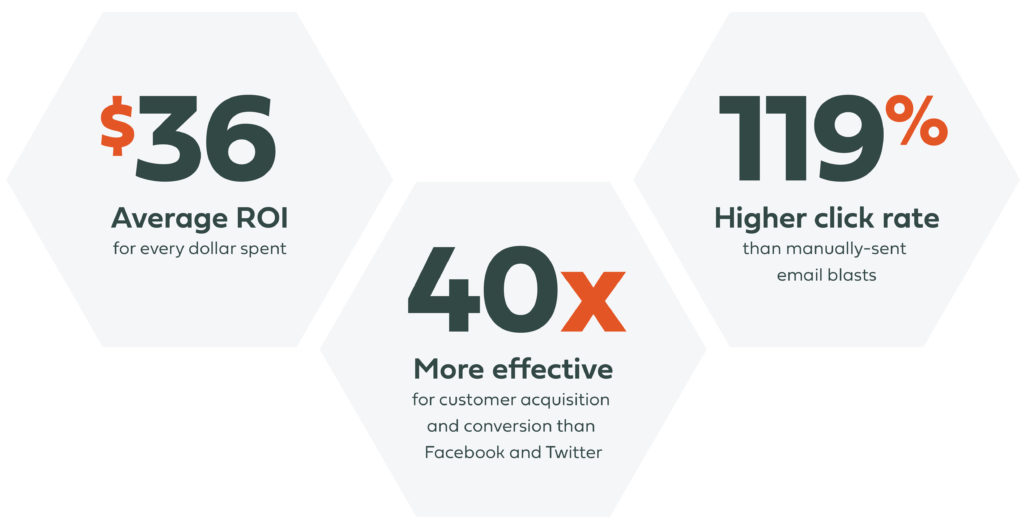Blog
Getting started with email marketing automation
Gearbox Functional Creative
There’s a reason email is the most commonly automated marketing method. By taking advantage of email automation, marketers can deliver consistent, customized content to their target audiences while they:
• Reduce the time spent manually scheduling and sending emails
• Nurture potential customers who’ve engaged with their brand
• Earn higher conversion rates from more qualified leads
In addition to making life easier, email marketing automation pays off. A study by McKinsey & Company found that email is about 40x more effective for customer acquisition and conversion than Facebook and Twitter. Both B2B and B2C customers expect email outreach from brands, and automated emails generally see a 119% higher click rate than manually sent email blasts.
What’s more, email marketing has an average ROI of $36 for every dollar spent, according to Litmus, The ROI of Email Marketing.
Email automation that nurtures potential customers who’ve engaged with your brand (through a sign-up form, previous purchase, or other outreach) can take them from consideration to conversion.
It’s important to note here that email automation doesn’t exist in isolation from your other marketing efforts across various channels. It should complement your other channels and work in unison with them.

How do I build an email marketing strategy?
To start building an automated email campaign, there are a few key steps you need to take:
1. Identify your target audience.
This is where every marketing effort begins—knowing who you’re trying to reach, what their mindset is about your product or service, and what pain points they’re experiencing that your company can solve.
Unless you know your target audience, you can’t effectively tailor email content to address their needs. Many marketers will create buyer personas at this stage to get a clear understanding of each buyer. Are there multiple groups who might be interested in your product? If so, how are their needs different and how does your product address their varying concerns?
2. Develop valuable content.
It’s important to give your audience a reason to open an email. If you don’t, there’s a good chance your prospects will hit the unsubscribe link. When you’re mapping out your communication strategy, be sure to create a variety of content that addresses different customer needs at various stages of the customer journey.
Valuable content doesn’t necessarily mean new content. Remember that email is just one outlet in your overall content marketing strategy. If you also create blogs, videos, newsletters or other resources, you can incorporate these into your email campaign. A study by The Lenskold and Pedowitz Groups found that automated messages help marketers repurpose 61% more content than ad hoc messages, meaning that content you create for your website or blog is working more than twice as hard when you employ it in your email automation efforts.
3. Identify the entry point to your email campaign.
Automated drip campaigns need a trigger in order to begin, so you’ll need to determine how your prospects are going to pull that trigger. Have they filled out a contact form on your site, downloaded a resource, or clicked on a “subscribe” button in order to get a discount code? The initial trigger of the campaign will determine the type of content you’ll be sending down the road.
For instance, someone who’s downloaded a white paper or other resource is likely in the early awareness stage, at the top of your sales funnel. They’re most likely just starting their research before making a purchase and need additional blogs, videos or other educational content to help in their decision making.
On the other hand, someone who has filled out a form in order to unlock a discount code is probably more ready to make a purchase. They’ll benefit more from content about product updates, complementary products and other promotions to increase brand loyalty.
4. Identify your ultimate CTA.
When thinking about your email campaign, consider what you want buyers to do when they reach the end of the drip campaign. Of course, your goal as a marketer is to drive conversions and purchases, but how will that happen? Your potential buyers should have a clear idea of what comes next. They’ve read your content and they’ve learned how your product or service can help solve their pain points. Are they ready to make a direct purchase? Or does your sales process dictate a consultation or demo of your product?
5. Map out your workflows.
Now that you’ve done the foundational work of identifying who your audience is, what content is most effective and relevant to deliver, and where you want your prospects to end up, you’re ready to start mapping your email campaign to your customer journey.
The customer journey is the decision-making process a potential customer goes through while considering your product. Your workflow should consider this process as you help them reach that decision. There are multiple approaches and various levels of sophistication you can build into your workflows, but the best place to start is by mapping your content on this journey. Consider where each piece of content will be most useful in the buyer decision process and map out touch points that help them reach your final call to action from your initial trigger.
If you’re ready to incorporate email automation into your marketing efforts, Gearbox can help you develop and implement an effective plan.